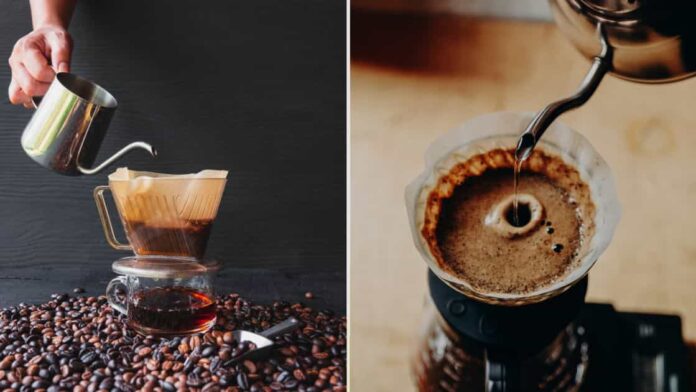Last Updated on June 23, 2024 by Sultana Parvin
Have you ever wondered what transforms simple coffee grounds and water into this delightful
beverage? The science behind coffee brewing is a fascinating interplay of chemistry and physics, with
water temperature playing a pivotal role in extracting the best flavors from your beans.
From unlocking notes of fruit and chocolate to ensuring a smooth, well-rounded cup, the
temperature of the water can make all the difference.
Join us as we explore how mastering this key variable can increase your coffee experience to a new level.
Table of Contents
How Water Temperature Affects Coffee Flavor?
Brewing coffee is a complex chemical process influenced by several factors, with water
temperature playing a crucial role.
Here’s a detailed look at how water temperature affects the flavor of coffee:
Extraction and Solubility:
The primary role of water in coffee brewing is to extract flavors from the ground coffee.
This extraction process depends on the solubility of the coffee compounds, which is highly
temperature-dependent.
● Low Temperatures (Below 185°F / 85°C): At lower temperatures, the extraction
process is slow. Coffee brewed at these temperatures often lacks the depth and
complexity of flavor, resulting in a brew that can be weak, sour, or underdeveloped.
● Optimal Temperatures (195-205°F / 90-96°C) This range is generally considered ideal
for coffee brewing. At these temperatures, water efficiently extracts the desirable flavors,
including acids, sugars, and aromatic compounds, leading to a balanced and flavorful
cup of coffee.
● High Temperatures (Above 205°F / 96°C): Brewing at higher temperatures can lead to
over-extraction, where bitter and astringent compounds are also dissolved. This can
result in a coffee that tastes overly bitter and harsh.
Chemical Reactions:
Different coffee compounds dissolve at different rates and temperatures, influencing the overall
flavor profile:
● Acids: These are among the first compounds to dissolve during brewing, contributing to
the coffee’s brightness and tangy flavors.
● Sugars: These dissolve next, adding sweetness and balancing the acidity.
● Bitter Compounds: These are extracted last, and high temperatures can lead to an
increased dissolution of these compounds, making the coffee taste unpleasantly bitter.
Consistency and Control:
Consistent water temperature is crucial for repeatable results. Fluctuations can lead to
inconsistent extraction, altering the coffee’s taste from one brew to the next. Precision tools like
gooseneck kettles and temperature-controlled brewers help maintain the ideal brewing
temperature.
Types of Coffee and Brewing Methods:
Different brewing methods and coffee types might require adjustments in temperature:
Espresso: Typically brewed at around 190-195°F (88-91°C), where precise temperature control
is essential for achieving the right balance.
Pour-Over: Generally done within the optimal range (195-205°F / 90-96°C), but slight
adjustments can be made based on the coffee bean’s roast level and origin.
Cold Brew: Uses room temperature or cold water over an extended period (12-24 hours). The
low temperature and long extraction time result in a smooth, less acidic, and less bitter coffee.
Is There a Perfect Coffee Brewing Temperature?
The perfect coffee brewing temperature is generally considered to be between 195°F (90°C)
and 205°F (96°C).
This range is recommended because it extracts the optimal balance of flavors from the coffee
grounds.
Different brewing methods may have slight variations in optimal temperature within this range.
For example:
● Drip coffee makers typically aim for around 200°F (93°C).
● Pour-over methods may prefer a slightly lower temperature, around 195°F to 205°F
(90°C to 96°C), depending on the specific technique and coffee used.
● Espresso machines often use a temperature around 200°F (93°C).
The best temperature may also depend on personal preference and the specific characteristics
of the coffee beans being used.
Conclusion
Water temperature is a critical factor in coffee brewing, directly influencing the extraction
process and the resulting flavor profile. By understanding and controlling water temperature,
coffee enthusiasts can enhance their brewing technique and enjoy a consistently delicious cup
of coffee.
